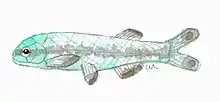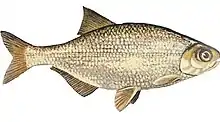| Freshwater elephantfish | |
|---|---|
 | |
| Gnathonemus petersii | |
| Scientific classification | |
| Domain: | Eukaryota |
| Kingdom: | Animalia |
| Phylum: | Chordata |
| Class: | Actinopterygii |
| Order: | Osteoglossiformes |
| Family: | Mormyridae |
| Subfamilies | |
The Mormyridae, sometimes called "elephantfish" (more properly freshwater elephantfish), are a superfamily of weakly electric fish in the order Osteoglossiformes native to Africa.[1] It is by far the largest family in the order, with around 200 species. Members of the family can be popular, if challenging, aquarium species. These fish have a large brain size and unusually high intelligence.
They are not to be confused with the marine and brackish-water callorhinchid elephantfish (family Callorhinchidae) of Southern Hemisphere oceans.
Description and biology
The elephantfish are a diverse family, with a wide range of different sizes and shapes. The smallest are just 5 cm (2.0 in) in adult length, while the largest reach up to 1.5 m (4.9 ft). They do, however, have a number of unique features in common. Firstly, their cerebellum is greatly enlarged, enabling them to interpret complex bio-electrical signals,[2] and to the large size of the valve.[3][4] Secondly, an auditory vesicle (a small bladder) is present inside the labyrinth of the left and right inner ears. This vesicle, together with a bag with an otolith (sacculum containing the otolith sagitta), itself communicating to the lagena (containing the otolith asteriscus), is in fact unique among vertebrates, completely independent of the other organs; it is neither connected to the labyrinth to which only one otolith bag (the utriculus containing the otolith lapillus) is attached, nor is it connected to the swim bladder (except in embryos) of which it has the same histological structure, nor is it therefore related to the pharynx.[5]
Some species possess modifications of their mouthparts to facilitate electrolocating and feeding on small invertebrates buried in muddy substrates. The shape and structure of these leads to the popular name "elephant-nosed fish" for those species with particularly prominent mouth extensions. The extensions to the mouthparts usually consist of a fleshy elongation attached to the lower jaw. They are flexible, and equipped with touch, and possibly taste, sensors. The mouth is not protrusible, and the head (including the eyes), the dorsum, and belly are covered by a thin layer of skin that is perforated with small pores leading to electroreceptors.
The retina is called a "grouped retina", an eye structure seen in mormyrids and a few other fishes.[6] Instead of being smooth, their retina is composed of tiny cups, acting like parabolic mirrors. Because of the murky waters they inhabit, the cones in their eyes have adapted to see only red light. The cups are made of four layers of light-reflecting proteins, funneling red light to areas of cones, intensifying its brightness 10-fold, while the rods are hit by light from other wavelengths.[7] Only a single gonad is present, located on the left side of their body.[8] The Mormyridae and the closely related genus Gymnarchus are also unique in being the only vertebrates where the male sperm cell does not have a flagellum.[9]
Electric fields

Elephantfish possess electric organs that generate weak electric fields, and electroreceptors (ampullae of Lorenzini, knollenorgans, and Mormyromasts) that detect small variations in these electric fields caused by the presence of prey or other objects of different conductivities. This allows them to sense their environment in turbid waters where vision is impaired by suspended matter.[10][11]
Electric fish can be classified into two types: pulse fish or wave fish. Pulse-type discharges are characterized by long intervals between electric discharges, whereas wave-type discharges occur when the interval between consecutive pulses is so brief that the discharges fuse together to form a wave.[12] The electric discharge is produced from an electric organ that evolved from muscle, as can also be seen in gymnotiform electric fish, electric rays, and skates. The convergent evolution between the South American gymnotiforms and the African Mormyridae is remarkable, with the electric organ being produced by the substitution of the same amino acid in the same voltage-gated sodium channel despite the two groups of fish being on different continents and the evolution of the electric sense organ being separated in time by around 60 million years.[13] Convergent changes to other key transcription factors and regulatory pathways in both Gymnotiforms and Mormyridae also contributed to the evolution of the electric sense organ.[14]
Classification
The roughly 221 species of elephantfish are grouped into two subfamilies, the Mormyrinae and Petrocephalinae. The latter has only a single genus:
| Phylogeny[15][16] | |||||||||||||||||||||||||||||||||||||||||||||||||||||||||||||||||||||||||||||||||||||||||||||||||||||||||||||||
|
Family Mormyridae
- Subfamily Mormyrinae
- Boulengeromyrus Taverne & Géry, 1968
- Brevimyrus Taverne 1971
- Brienomyrus Taverne, 1971
- Campylomormyrus Bleeker, 1874
- Cryptomyrus J. P. Sullivan, Lavoué & C. D. Hopkins, 2016[17]
- Cyphomyrus Pappenheim, 1906
- Genyomyrus Boulenger, 1898
- Gnathonemus Gill, 1863
- Heteromormyrus Steindachner, 1866
- Hippopotamyrus Pappenheim, 1906
- Hyperopisus Gill, 1862
- Isichthys Gill, 1863
- Ivindomyrus Taverne & Géry, 1975
- Marcusenius Gill, 1862
- Mormyrops J. P. Müller, 1843
- Mormyrus Linnaeus, 1758
- Myomyrus Boulenger, 1898
- Oxymormyrus Bleeker, 1874
- Paramormyrops Taverne, Thys van den Audenaerde & Heymer, 1977
- Pollimyrus Taverne, 1971
- Stomatorhinus Boulenger, 1898
- Subfamily Petrocephalinae
- Petrocephalus Marcusen, 1854
In culture
.jpg.webp)
The Medjed was a sacred fish in Ancient Egypt. At the city of Per-Medjed, better known as Oxyrhynchus, whose name means "sharp-nosed" after the fish, archaeologists have found fishes depicted as bronze figurines, mural paintings, or wooden coffins in the shape of fishes with downturned snouts, with horned sun-disc crowns like those of the goddess Hathor. The depictions have been described as resembling members of the genus Mormyrus.[18]
References
- ↑ Froese, Rainer, and Daniel Pauly, eds. (2017). "Mormyridae" in FishBase. April 2017 version.
- ↑ Chapman, Lauren J.; Hulen, Kevin G. (2001). "Implications of hypoxia for the brain size and gill morphometry of mormyrid fishes". Journal of Zoology. 254 (4): 461–472. doi:10.1017/S0952836901000966.
- ↑ Glickstein, M.; Voogd, J. (2009). "Cerebellum: Evolution and Comparative Anatomy". Encyclopedia of Neuroscience: 743–756. doi:10.1016/B978-008045046-9.00947-5. ISBN 978-0-08-045046-9.
- ↑ Wullimann, Mario F.; Rooney, Donal J. (1990). "A direct cerebello-telencephalic projection in an electrosensory mormyrid fish" (PDF). Brain Research. 520 (1–2): 354–357. doi:10.1016/0006-8993(90)91730-5. PMID 1698507. S2CID 12951395.
- ↑ Orts, S. (1967): Contribution to the comparative anatomy and systematics of Mormyroïdes (RAOS Prize 1966) - Ann. Acad. Roy. Sc. d'Outre Mer, Classe des Sc. Nat. et Méd., Bruxelles, XVII, 3, 1-89, 30 figs, 3 tabs, 8 pls, 1967 (in French)
- ↑ Francke, Mike; Kreysing, Moritz; Mack, Andreas; et al. (2014). "Grouped retinae and tapetal cups in some Teleostian fish: Occurrence, structure, and function". Progress in Retinal and Eye Research. 38: 43–69. doi:10.1016/j.preteyeres.2013.10.001. PMID 24157316. S2CID 39081714.
- ↑ Elephant-Nosed Fish Has Funky Eyes, Too
- ↑ Communication Behavior and Sensory Mechanisms in Weakly Electric Fishes
- ↑ Miller, S.; Sullivan, J. "Mormyridae Bonaparte, 1831". Mormyridae - African weakly electric fishes. Retrieved 20 October 2023.
- ↑ Bustami, H.P. (2007). Smart elephant fish navigates in darkness with electric fields. life-of-science.net
- ↑ The generation of these electric fields and their use in providing the fish with additional sensory input from the environment is the subject of considerable scientific research, as is research into communication between and within species
- ↑ Caputi, A. A. (1999). "The electric organ discharge of pulse gymnotiforms: the transformation of a simple impulse into a complex spatiotemporal electromotor pattern". Journal of Experimental Biology. 202 (# (Pt 10)): 1229–1241. doi:10.1242/jeb.202.10.1229. PMID 10210664.
- ↑ Arnegard, M. E.; Zwickl, D. J.; Lu, Y.; Zakon, H. H. (2010-12-02). "Old gene duplication facilitates origin and diversification of an innovative communication system--twice". Proceedings of the National Academy of Sciences. 107 (51): 22172–22177. doi:10.1073/pnas.1011803107. PMC 3009798. PMID 21127261.
- ↑ Gallant, Jason R.; Traeger, Lindsay L.; Volkening, Jeremy D.; Moffett, Howell; Chen, Po-Hao; Novina, Carl D.; Phillips, George N.; Anand, Rene; Wells, Gregg B.; Pinch, Matthew; Güth, Robert (2014-06-27). "Genomic basis for the convergent evolution of electric organs". Science. 344 (6191): 1522–1525. Bibcode:2014Sci...344.1522G. doi:10.1126/science.1254432. PMC 5541775. PMID 24970089.
- ↑ Lavoué, S.; Sullivan, J. P.; Hopkins, C. D. (2003). "Phylogenetic utility of the first two introns of the S7 ribosomal protein gene in African electric fishes (Mormyroidea: Teleostei) and congruence with other molecular markers". Biological Journal of the Linnean Society. 78 (2): 273–292. doi:10.1046/j.1095-8312.2003.00170.x.
- ↑ Sullivan, J. P.; Lavoué, S.; Hopkins, C. D. (2000). "Molecular systematics of the African electric fishes (Mormyroidea: Teleostei) and a model for the evolution of their electric organs". Journal of Experimental Biology. 203 (Pt 4): 665–683. doi:10.1242/jeb.203.4.665. PMID 10648209.
- ↑ Sullivan, J. P.; Lavoué, S.; Hopkins, C. D. (2016). "Cryptomyrus: a new genus of Mormyridae (Teleostei, Osteoglossomorpha) with two new species from Gabon, West-Central Africa". ZooKeys (561): 117–150. doi:10.3897/zookeys.561.7137. PMC 4768369. PMID 27006619.
- ↑ Van Neer, Wim; Gonzalez, Jérôme (2019). "A Late Period fish deposit at Oxyrhynchus (el-Bahnasa, Egypt)". In Peters, Joris; McGlynn, George; Goebel, Veronika (eds.). Documenta Archaeobiologiae Animals: Cultural Identifiers In Ancient Societies? (PDF). Rahden, Westfalia, Germany: Verlag Marie Leidorf. ISBN 978-3-89646-674-7.
External links
 Media related to Mormyridae at Wikimedia Commons
Media related to Mormyridae at Wikimedia Commons Data related to Mormyridae at Wikispecies
Data related to Mormyridae at Wikispecies- Detailed research paper on the sensory and central nervous systems in Gnathonemus petersi
- Mormyrids in the aquarium
- Mormyridae - African weakly electric fishes (including interactive checklist)


.jpg.webp)